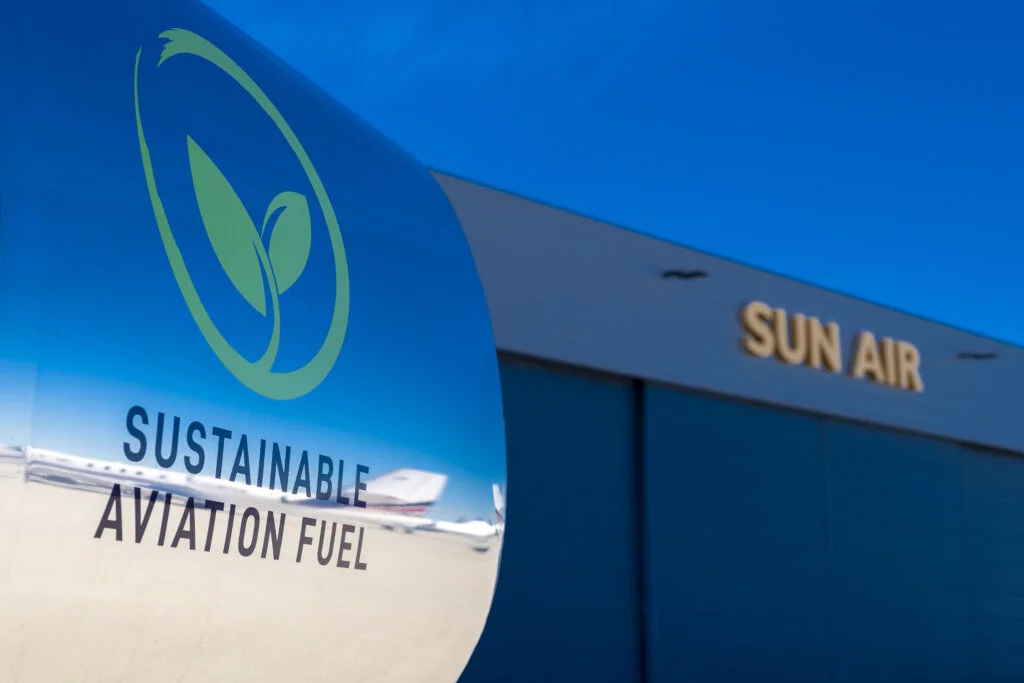Jet fuel and AVGAS have been around for many years, but as companies explore more green and sustainable options, they have been looking for additional fuel sources. There are many different aircraft types, but they don’t all use the same aviation fuel. The type used depends on the design of the aircraft’s engine. There is a wide range of aviation fuels on the market today so let’s look at some of the top options.
1. Jet Fuel
Jet fuel is a type of aviation fuel used to power aircraft with turbine engines, including jet engines (as the name suggests) and turboprops. There are different types of this type of fuel that can be found, with the primary being Jet A, Jet A-1, and Jet B. Let’s take a closer look at each.
Jet A Fuel
Jet A is the most common aviation fuel type in the United States. It is a kerosene fuel with a higher flash and freezing point than standard, commonly-used kerosene. Many jets and turboprops run well on Jet-A fuel.
Jet A-1 Fuel
On an international level, Jet A-1 is the most commonly used aviation fuel type. Its freezing point is lower than Jet A, meaning it can work well in nearly any climate. Plus, it has additives that reduce the number of static charges.
It is not uncommon for jets to switch back and forth between Jet A and Jet A-1 aviation fuel.
Jet B Fuel
Jet B fuel is a mixture of kerosene and gasoline, commonly 35% to 65%, respectively. It works well and is often the most sought alternative to the aviation fuel types mentioned above. Jet B fuel is often used more for just jet engines and not for turboprops.
Issues Involving Jet Fuel
There are several different types of jet fuel consumed daily around the world. But not all of them are without issues. The biggest problem is contamination which often comes from water and fuel-consuming microbes. The water may dissolve into the fuel, but any remaining water can allow microbes to grow and live on the power. This build-up causes microbial contamination and constant threat – presenting issues such as clogged filters, the corrosion of tank coatings, and degraded fuel. Aviation specialists take different measures to help limit microbial growth.
2. AVGAS Aviation Fuel
AVGAS stands for aviation gasoline. Small private aircraft and older propeller planes are the only consumers of this fuel type. In other words, it works well for aircraft with engines requiring leaded fuel (tetraethyl lead) and a high octane number, such as 100. For an engine to run on avgas, it has to have a gasoline engine.
One of the biggest downfalls of avgas is its cost. It is a costly fuel type as most of the industry has shifted its product to other fuel types. The result? Remember, any turbine-powered aircraft (as well as those with diesel engines) will always require kerosene, i.e., jet fuel. Those needing avgas face challenges with slow production and long waits.
The Need for Sustainable Aviation Fuel
Between jet fuel and avgas, the aviation world is looking for something new that will lower their carbon footprint in the future. In other words, a sustainable aviation fuel that will be ecologically friendly. The industry-wide goal is to reach carbon neutrality by the year 2050 in the U.S.
The idea behind this new fuel type is that it has to be as efficient as current types of aviation fuel and readily accessible. Making it easy to obtain and its overall ease of use without issue will make it a better fit for the industry that always runs on time. Everything from renewable energy sources to hydrogen power and even electric batteries have been discussed and considered as options.
The good news is the push for cleaner and healthier alternatives are there. Even natural gasses have the potential to make a difference since they have nearly 30% fewer emissions than the current jet fuel. And one day, fossil fuels that have been around for decades will be replaced – or at least outnumbered – by all the aircraft burning sustainable, environmentally-friendly fuels. Combining sustainable aviation fuel and carbon offsets will help reduce our carbon impact.
3. Biokerosene Aviation Fuel
Biofuel is made from renewable or recycled organic material and can come from all sources. For instance, oil seeds like sunflower and palm will work, as well as used oil and grease from restaurants, farm waste from the agricultural industry, and more. The fuel forms from microalgae that scientists cultivated in a tank. There are so many advantages to biofuels in the aviation industry, such as:
- They won’t require many engine overhauls;
- They could cut co2 emissions caused by air travel by as much as 90%;
- And they should be relatively easy and accessible when they become more readily available.
Currently, the industry is testing different options to see what the safest, most effective, and efficient options may be. One that had several successful tests is biokerosene. Biokerosene is a mixture of both biofuel and kerosene, hence the name. It is currently being researched to see if it can work in the long-run using algae or biofuels from camelina oil and jatropha. Unfortunately, even though the technology is there to make this a more commonly used fuel, there is no industrial-scale production.
Key Takeaways on Aviation Fuel
The aviation world accounts for a lot of the air pollution left behind. This pollution is why we need to make strides to find a cleaner and more sustainable fuel source. Until then, understanding the different types of aviation fuel, avgas, and biokerosene (or other biofuels) and which engine requires each, you should have what you need to get by. Regardless of your aircraft type, stopping to refuel should be an easy, hassle-free experience every time.


No comments for “3 Popular Types of Aviation Fuel to Know”